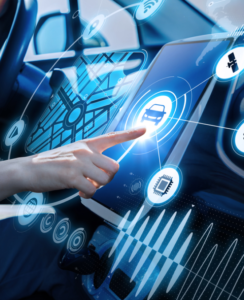Connectivity is the driving force behind the future of automotive innovation, but challenges and risks remain in the road to success.
Connectivity has become a buzzword in the automotive sector, and for good reason. By 2030, around 95% of new vehicles sold globally will have embedded internet connectivity, up from around 70% today.
From connected apps to integrated voice controls and autonomous driving capabilities, more and more buyers expect a seamless connected-car experience. That said, challenges remain, particularly with regards to safety, cybersecurity, and digital privacy.
Automotive connectivity has come a long way since the first car radios of the late 1930s. Now, the majority of light vehicles sold in Europe and North America feature embedded connectivity, meaning they’re equipped with a built-in modem allowing them to receive 4G and 5G cellular data. Tethered connectivity, which requires connecting to a driver’s smartphone to borrow its access to the internet, is even more common, especially for older and lower-end vehicles.
While tethered connectivity allows drivers to seamlessly connect third-party services, such as music-streaming, hands-free calling, and satellite navigation, to their in-car experiences, it’s the rise of embedded connectivity that’s really transforming the industry. At minimum, most automakers embed connectivity for critical functions, such as automated crash notification and remote control.
We’re now witnessing a new era of in-car connectivity, driven by the evolution of 5G-enabled vehicle-to-everything (V2X) technology. This allows direct communication between vehicles and nearby road infrastructure, external networks and devices, and other vehicles. V2X serves various purposes, such as providing safety-related notifications and optimising the efficiency and flow of traffic in real time. That also makes V2X essential in autonomous vehicles.
 According to a study by consulting firm BearingPoint, 59% of connected-car owners said that in-car connectivity options were a significant factor in their choice of vehicle, while a third said it was a primary factor in their purchase decisions.
According to a study by consulting firm BearingPoint, 59% of connected-car owners said that in-car connectivity options were a significant factor in their choice of vehicle, while a third said it was a primary factor in their purchase decisions.
Since people are used to being online and often spend several hours every week in their cars, it shouldn’t come as a surprise that dashboards have now become digital platforms. By 2020, revenue from these connected systems had already surpassed $150 billion globally.
To keep up with growing demand, automakers are now offering a broader range of connected features, ranging from in-car entertainment apps to safety-management features. Consumer expectations are rising too, driven largely by the rapid growth of autonomous vehicle functions and electric cars.
The connected car also offers unprecedented opportunities for automakers to leverage data to generate new insights into drivers’ preferences and behaviours. These insights can support everything from sales and marketing initiatives to research and development to maintenance and support.
Despite the unstoppable rise of innovations like automotive connectivity, artificial intelligence, and autonomous driving, significant challenges remain. Designing and building cars equipped with embedded connectivity is inherently complex, especially when it comes to addressing the risks.
While consumer interest in connected vehicles continues to grow, almost two thirds of buyers are concerned that buying one would compromise their privacy. Over half are concerned about possible cyberthreats.
In 2022, the US Consumer Watchdog published a report raising awareness to the potential of connected vehicles being used to track drivers. With new vehicles being equipped with myriad sensors, including cameras and microphones, it shouldn’t be difficult to understand the rising privacy concerns among consumers. Automakers need to make every effort to assuage these concerns and, in doing so, ensure compliance with regulations like GDPR and CCPA.
Arguably an even greater concern is the cybersecurity threats facing connected vehicles. Any device connected to a network is a potential target for a hacker, and a connected vehicle is no exception. The broader the connectivity, the more vulnerable it becomes to hacking, which clearly has deeply concerning implications for driver safety and security. As such, automakers must invest in robust security measures to protect both vehicles and their drivers.
Factors like driver experience, functionality, cybersecurity, and data privacy should never be viewed as competing disciplines, but as integral parts of a greater whole. Customer demands will only continue to evolve across all the aforementioned areas, so automakers must make every effort to ensure their vehicles meet and surpass regulatory standards and expectations alike.
Ultimately, the success of connected vehicles depends on how well manufacturers can meet the demands for functionality, security, and privacy.
Join the conversation about the future of automotive innovation at the ICA Summit on May 15-16 in Frankfurt, Germany.